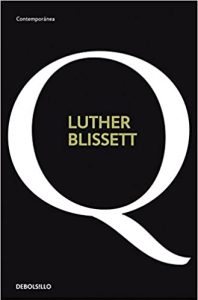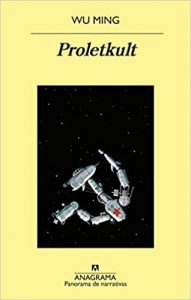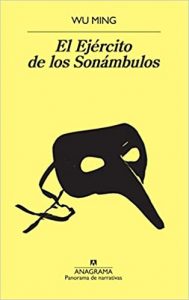The thing about five authors writing the same work together sounds interesting at first. Experimental roll. But then, once you consider how difficult it is to write a novel with four hands, getting down to ten must be maddening. At best like Maj Sjöwall and Per Wahlöö, creators for a decade of crime novels of great commercial pull, everything is understood from the sentimental relationship. And other similar cases of pairs have also borne fruit in specific encounters or as a constant creative.
Because in literature as in sex the understanding between two can be good, while the crowd can be disorder and chaos. It is already announced by the joke of the participant in the orgy asking for organization, more than anything because he has already taken six lunges from behind when there are only five.
Wu Ming were just that, five types of writers all of them, obviously. Let's not rule out that the thing will finally remain in a quartet after a confrontation and its resolution via crime with the dissident ... 😛
The thing went well and the Wu Ming 1,2,4, 5, 1999 and XNUMX continue to hang out, smoking joints or taking acid, and writing new stories. They do well and because of the avant-garde of the matter plus the currado and varied of their plots, they continue to find a market since the remote dawn of the new millennium (to give more packaging to the matter, or that since XNUMX)
Top 3 Recommended Novels by Wu Ming
Q
Once they got involved, the four authors involved in this first novel, Federico Guglielmi, Giovanni Cattabriga, Luca Di Meo and Roberto Bui (self-styled Luther Blissett) had the balls to write a sublime work at the first turn.
It must have been that ten eyes see more than two in the same way that 5 egos can exercise better self-criticism exercises than a single ego inflated by how the work is turning out.The point is that Q had that perfect amalgamation point, of mixing heterogeneous but wisely conducted as a well-put together novel. The richness of this exercise in nuances and recognitions underpinned the project.
Rated by critics as a masterpiece and insistently compared to The Name of the Rose, Q It is a long novel set in the XNUMXth century. The work takes place over thirty years in different countries of Counter-Reformation Europe, and in it dozens of characters make up a prodigious fresco of the time.
Thus, Q It is a historical novel, but also, and above all, it is an adventure and espionage novel where the true protagonist is the crowd: heretics, spies, whores, courtiers, mercenaries, improvised prophets, servants ... A choral novel in style and content that In all the countries in which it has been translated, it has been a resounding success.
Proletkult
A novel much more devoted to an avant-garde task of synthesis during some very interesting creative process to achieve the final point between dystopian, absurd, satirical and fast-paced action. A lysergic review of all those novels that predicted social collapse towards alienation and the control of wills in as many different ways as they could imagine. George Orwell o Huxley among others.
In 1907, in Tbilisi, Georgia, a Bolshevik revolutionary named Leonid Voloch assaults a postal carriage protected by Cossacks and flees on a train with the help of a Georgian comrade. They jump off the moving train and the Georgian leads him through a forest to a strange transparent sphere, no less than eight meters high and with various presences inside, which opens to receive them.
At that moment the Georgian unbuttons the collar of his coat, slides the fingers of both hands and removes the mask that served as a face, including dark hair and mustache. Then an alien being with vaguely human features appears ...
Many years later, Leonid's supposed daughter, who is also a supposed alien, looks for her father to take him back to the planet Nacun. To do this, he visits Alexandr Bodgánov in the already revolutionary Moscow, a real character who seems to have come out of a novel: doctor, economist, philosopher, founder and ideologist of the proletarian art movement called Proletkult, science fiction writer and director of a pioneering transfusion center in the cure of nervous diseases (and perhaps in the pursuit of eternal youth). And so, in this pastiche of socialist realism and science fiction (also socialist), there appear exiled revolutionaries in Capri, secret policemen, interplanetary civilizations organized in perfect communist societies, Capital and a landmark socialist science fiction titled ―How not― Red Star, Lenin and Stalin ...
And, with all these elements, the Wu Ming collective creates a devilish and appetizing literary artifact that plays with genres and explores the relationship between revolutionary and mental delusions; between human and political follies; between daydreams, ideals and fantasies (political and literary); between reality and fiction.
The army of sleepwalkers
Don't tell me the title isn't suggestive. From the outset the idea of all of us sleepwalking, with our arms at right angles forward, stripped of will and repeating some dreamlike slogan induced by some behavioral therapy.
Then comes the usual changing scenery of this group of writers united for the end of the literary glory made from God knows what a conspiracy to make the sum possible. Some of them, of the authors, would point to the historical novel, to the starting point . And everyone would accept it, nothing better than the French Revolution as a starting point to project ideas about violence, the search for horizons after the revolution, subsequent failures and all the play of light and shadow that appear as on the world stage, waiting if the human can finally come to terms with some sense.
Paris, January 1793. King Louis XVI is about to be guillotined and the city bustles with the enthusiasm of the supporters of the new order and the conspiracies of the monarchists. Terror will not be long in coming, and the Revolution will enter a critical phase. In this atmosphere of chaos, power games, political ambitions, dreams of freedom and violent nightmares, several characters move: Orphée d'Amblanc, a peculiar doctor who in the middle of the Revolution puts into practice the teachings of his teacher Mesmer, father of modern hypnosis ; Marie Nozière, who struggles to raise her son and dreams of a new life in which there is equality between the sexes; Leonida Modonesi, an Italian actor who admires Goldoni who has come to the capital with the purpose of locating his old idol and will end up disguising himself as Scaramouche and acting between theater and real life ...
And in this climate of uncertainty, rumors arise of a growing number of inexplicable cases of sleepwalking, victims of a strange evil that annihilates their conscience. D'Amblanc will be commissioned to investigate what is true in these rumors, because it is suspected that the monarchist counterrevolutionaries may be creating an army of sleepwalkers. Ingenious pastiche of historical novel and adventure drama; brilliant exercise in scholarship; reflection on power, violence and the upheavals of history; Agile and fast-paced story, full of unexpected twists and surprises, The Army of Sleepwalkers is above all a literary feast, a gift for the reader.




1 comment on “Discover the 3 best books by the Wu Ming collective”